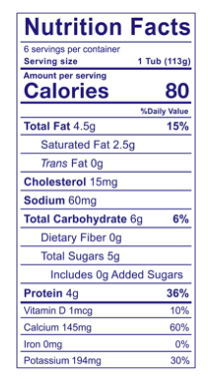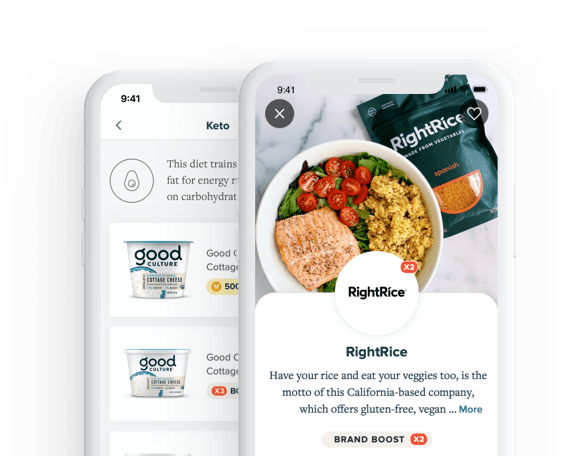Stories
Nutrition Label 101
Kim McDevitt
How often do you pay attention to that finely-printed label on the back of all your packaged foods and drinks? While not the tell-all of the “health” of the food, having a basic understanding of the purpose of these labels can help guide you in making dietary choices that better fit your own personal health and wellness goals.
The Nutrition Facts Label is found (and required, according to the FDA) on all packaged foods and drinks, typically located on the back or side of the container.

Here’s the breakdown of this label:
Serving Size The serving size of the food is listed first, with many brands recently also showing them front of pack. Why is recognizing this number so important? Because all the lines below it are meaningless without context of the quantity it’s referencing. You’ll see on the first line the number of servings in the package and then also how much the manufacturer considers to be one serving. In this case, there are 6 individual servings in this package and each serving is considered one 1 tub. Meaning, all numbers below reference 1 tub of the food. Individual servings can also be written in other volumes such as in cups or ounces.
Calories
Calories are a measure of the amount of energy you’re getting from a food. Once believed to be the guiding factor for your food choices and health, today we know more than ever that not all calories are created equal, meaning there’s more to consider than just the caloric number. That said, sheer calorie counting can help with weight maintenance, loss or gain.
Total Fat
Not all fat is bad, so it’s okay if you don’t always see the lowest number here. In fact, sometimes a moderate amount of fat is in your favor when it comes from healthy sources such as monounsaturated fats and omega-3 fatty acids (think avocados, almonds, olive oil or salmon to name a few). While some health conditions require moderation or tracking of that total fat number the majority of us should be looking primarily at the two lines below Total Fat: Saturated Fat and Trans Fat * Saturated Fat Found in meats, dairy and some oils aim for eating saturated fats in moderation and strive for low levels in your packaged food choices. * Trans Fats Trans fats are considered the most unhealthy source of fat to include in your diet and should be avoided.
Sodium
Sodium (salt) can either be naturally occurring or often times added to increase flavor profile of the food. Most common foods you’ll find it added to are soups, salad dressings and snacks. While foods that naturally contain sodium are fine to consume, keep numbers low in those foods that have sodium (or salt) added — typically in much higher levels than your body needs.
Total Carbohydrate
Carbohydrates are macronutrients that provide energy to the body. But those following a low carbohydrate dietary lifestyle are particularly mindful of this number. Quality of carbohydrates matters — yes, both candy and popcorn are carbs, though one delivers whole grains and fiber (popcorn) than candy (refined sugar). Rather than focus heavily on the total carbohydrate number, pay closer attention to the two numbers below: Fiber and Sugar.
Fiber
Fiber (soluble or insoluble) is an indigestible type of carbohydrate and one everyone can benefit from! It keeps your gut happy, keeps you full and keeps you regular. You want to aim for at least 25g of fiber per day which means the more fiber listed the better! And, because fiber is a type of carb your body doesn’t digest, you can subtract the grams of fiber from total carbohydrate number if you’re ‘carb counting’ or watching your total carb intake.
Sugar
Also a type of carbohydrate, sugars are found naturally in foods but also added. You’ll notice the new labels have a line for total and added sugars. While total is important to be mindful of added sugars are what you want to look at, since that number reflects the addition of more highly processed forms of sugar. The lower the amount of added sugars the better.
Protein
The last of your macronutrients, protein is the nutrient essential for many jobs in the body including cell maintenance and muscle development. Higher protein food options typically will help keep you full and satisfied.
Micronutrients
Finally, the FDA has deemed the last four vitamins and minerals ones to be aware of (more so than others) when purchasing packaged foods. These nutrients all have a different role within the body and can be learned about in more detail from the FDA.
Apple and the Apple logo are trademarks of Apple Inc., registered in the U.S. and other countries. App Store is a service mark of Apple. Google Play and the Google Play logo are trademarks of Google LLC.
